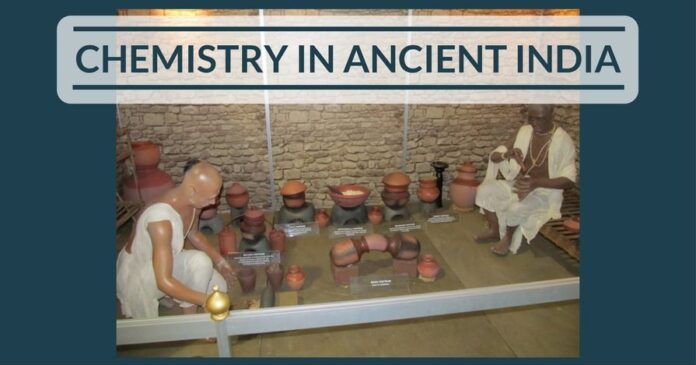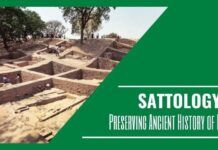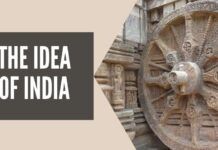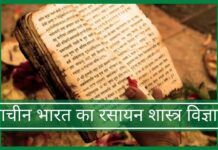
In this article some facts are highlighted regarding the role of ancient India in chemistry
Background:
In the current generation, one can find a large number of youngsters who think that in the past, India had no knowledge of science. They also believe that our ancient texts were full of religious orthodoxy and did not contain any scientific knowledge. Some of the youngsters also believe that British taught us science and before them, India didn’t have any knowledge of modern science. After listening to all these allegations since childhood, I decided to do some research on the subject. I started scanning some old libraries, ancient books, and books written by indigenous people on our ancient history. While doing that, I found a large number of documents related to Ancient Indian science – Astrophysics, Chemistry, Mathematics etc. After finding these documents, I realized, how less we Indians know about our ancient past. With that thought in mind, I decided to write articles about ancient India. As I cannot write everything in one go, I decided to take the subjects one by one. In this article, I am writing about ancient Indian Chemistry.
India has a very ancient tradition of chemistry. In ancient texts, amazing information is available on metals, ores, their quarries, compounds, and alloys. There are also details of hundreds of devices used in chemical experiments in ‘Rasayan Shastra’ which we call ‘chemistry’. There have been many chemists in the past, the creations of some of them are as follows:-
• Nagarjuna- Ras Ratnakar, Kakshaputtantra, Arogya Manjari, Yog Saar, Yoasthak
• Vaagbhatt- Rasratna Samuchchay
• Govindacharya- Rasarnava
• Yashodhar- Ras Prakash Sudhakar
• Ramchandra- Rasendra Chintamani
• Somdev- Rasendra Chudamani
The following chemicals has been mentioned as main chemicals in the ‘Ras Ratna Samuchchay’ book-
(1) Maharas (2) Upras (3) Samanya Ras (4) Ratna (5) Dhatu (6) Vish (7) kshar (8) Aml (9) Lavan (10) Lohbhasm।
In the same way, the book has also described 10 types of poisons which could also be used for medicinal purposes.
The existence of laboratory in Ancient India:
The description of a Chemistry laboratory is mentioned in the 7th chapter of ‘Ras Ratna Samuchchay‘. More than 32 instruments were used in it, the main ones are-
(1) Dol Yantra (2) Swedani Yantra (3) Patan Yantra (4) Adhaspadan Yantra (5) Dheki Yantra (6) Baluk Yantra (7) Triyak Patan Yantra (8) Vidhyadhar Yantra (9) Dhup Yantra (10) Koshthi Yantra (11) Kachchap Yantra (12) Damru Yantra
In any country, scholars have to depend on three types of evidence to study the emergence and development of a particular knowledge
In the laboratory, Nagarjuna has done several experiments based on mercury. He has explained the methods of purifying and medicinal use of mercury in detail. In his texts, Nagarjuna has given the method of preparing a mixture of various metals, purification of mercury and other metals, purification of Maharas, and converting various metals into gold or silver. Mercury was not only used for converting metals but it was also used for good health and longevity. In India, ‘Para’ (Mercury) was considered to be Shiva element and ‘Gandhak’ as Parvati element and when both of them were joined with ‘Hingul’, it was called Rassindur, which was considered as a life-enhancing essence.
From these texts, it is also known that a Rasa-Shastri used to perform various purification procedures to remove the harmful properties of metals and minerals, to make them useful for internal use and to make them pure. In it, the mercury had to undergo eighteen types of the purification processes. The abrasion of mercury with juice and spices of medicinal herbs and combining it with asbestos and some alkalis are important in these processes. Ancient chemistry experts believed that after passing through seventeen purification processes, all the possibilities of transformation (in the form of gold or silver) in mercury should be examined. If it comes out desirable in the test, then it should be applied in the process of the eighteenth purification. Similarly, there were many methods of treating metals in India.
. . . to be continued
History of Chemistry in India:
For dwelling on the origin and development of ancient knowledge of any country, scholars often rely on the following sources-
1. Ancient history of the region
2. Traditional knowledge
3. Archeological evidence
Therefore, to dig deep into historical antecedents of the development of Indian chemistry, it is apt to study the vast ancient literature. It is important to note that the ‘vedas’ is considered as one of the foremost means to gather knowledge on different facets of India’s past. Out of the Four Vedas, it is also largely accepted that Rig Veda is the most ancient of them all. It was from around 18th century BC, that people started discovering new elements. Before this, humanity was aware of only 7 metals, namely – gold, silver, copper, iron, tin, lead and mercury. There is a detailed mention of all these metals in our ancient scriptures including the Rigveda, Yajurveda, and Atharvaveda. The Vedas go back to around 1000 BC. The facts help us arrive at the conclusion that the discipline of chemistry finds its origin in India at around 1000 BC.
Likewise, in the post-Vedic era, we find references of the world famous ‘Sushrut Samhita’ and the medicinal experiments using Mercury, Zinc, Copper and other metals and acquiring their pure form from their alloys. Undoubtedly, for such expertise, knowledge in the discipline would have been acquired long before. It is noteworthy after these scriptures were written, in the same century (3rd century BC) Kautilya (Chanakya) made references to metals, alloys, minerals and ores in the ‘Arthashastra’. There is a detailed and astounding explanation of their mining, distribution, arrangements of mines and metallurgy. This text represents one of the most important ancient evidence of India’s contribution to science. From the Second till the 12th century of the 1st millennium, we find volumes of such books dealing exclusively with chemicals, procedures, experiments with descriptive observations and analysis. In these, we find a detailed explanation of metals, minerals, ores, metallurgy, alloys, catalyst, theoretical and experimental chemistry and hundreds of devices used in the labs.
The quality of Indian steel was so high that the historical evidence of export of swords made from them to Persia etc. were found.
Take the book ‘Ras Ratnakar’ written by Nagarjuna in the second century. It is believed that a Buddhist chemist of this name, born in the sixth century, reviewed this book. That’s why this book is available in two forms. Anyways, this book has got the ultimate knowledge of chemicals in its own. In the sixth century, Varahamihari has described the method of building extremely high-grade steel to make arms and ammunition in his ‘Vrihat Samhita’. The quality of Indian steel was so high that the historical evidence of export of swords made from them to Persia etc. was found.
Similarly, from 8th century to 12 century– ‘Ashtang Hridayam’ of Vagbhatt, ‘Rashridaytantra’ and ‘Rasarnav’ of Govind Bhagvatpad, ‘Rasarnavakalp’ and ‘Rasendra Chudamani’ of Somdev, ‘Rasendrasar Sangrah’ of Gopal Bhatt and several other books like Raskalp, Rasratnasamuchchay, Rasjalnidhi, Rasprakashsudhakar, Rasendrakalpdrum, Raspradeep and Rasmangal etc books were written in India.
According to British documents, in India during 1800 about 20,000 kilns used to get various metals, of which ten thousand were only iron-building furnaces and 80,000 workers were employed. The quality of the steel product manufactured in India during that time was better than the steel of Sweden which was considered to be the best at that time. The witness is Captain Pressgrain, the British Manager of the then coin construction factory, and another Englishman Major James Franklin. Many other items of iron, such as soap, ammunition, indigo, ink, sulfur, copper, zinc etc. were also being prepared from Indian technology, at that time and long after it. Very soon after the advent of western technology during the British rule Indian technology was forgotten.
Way forward:
These are just a few examples, on the basis of which it can be said that there has been a wonderful tradition of chemical science in India for thousands of years. Due to the attacks of foreign invasions and the destruction of Sanskrit literature in the period of slavery, this tradition decreased. It is necessary today to study some of the ancient texts of Sanskrit with some people who have a knowledge of modern science, thereby learning from ancient as well as modern science, the research of chemistry and Ayurveda should be encouraged in accordance with India’s environment, climate, and nature. India’s ancient science and precious knowledgeable books today are lying with dust in ancient libraries due to the ignorance of Sanskrit and Indian texts. It is hoped that the Government of India will pay attention to it and set up the committee to revive it. In today’s era, it is also necessary to preserve the ancient wisdom along with modern science, because when a society does not protect ancient knowledge in the mess of renewal, they have to waste several years to gain that knowledge in the future.
Note:
1. The views expressed here are those of the author and do not necessarily represent or reflect the views of PGurus.
- Chemistry in Ancient India - January 2, 2018
- प्राचीन भारत का रसायन शास्त्र विज्ञान - December 28, 2017
- क्या भारत शूद्र विरोधी था: एक ऐतिहासिक विश्लेषण – भाग २ - December 15, 2017











Till 17th century the knowledge levels across all civilization was more or less same. Everyone contributed equally good. Chine, Indian, Persian, European and you can name few more on country basis. Genius were equally distributed.
But then an exponential jump had happened in European scientific growth from 16th century beating others by huge margin.
This jump made others pygmies before them. In 300 years a population may one fourth to us made unexplainable differences. Now other countries are catching up. There should be research why this happened in Europe, when we were all same and what advantages or different environment helped them to move so fast.
share this to all
Excellent piece of article by Shubham Verma .I personally think not to blame any generation as we too follow the same .I being a scientist feel criticizing any one is not the solution .India has deep wealth of knowledge which was hidden from the world for many decades because of frogein invasion .The gov must take cognizance and start a reserach progarame for ancient science and technology with collaboration with mordern science and how it can take best out of it.
Word by word, this is gem of an article. I feel proud of our ancestors before 10 generations & previous. At the same I feel ashamed of our last 3 or 4 generations who started aping the West – ignoring our golden past, knowledge, culture & education.
–
Agriculture, Medicine (Preventative & curative), Education, Engineering – name any profession – Our ancestors excelled beyond comprehension.
–
I fully agree with the author – Sanskrit shall be reintroduced in the curriculum to treasure hunt our ‘vedic age knowledge banks’.
–
India had expert STEEL MANUFACTURERS who could manufacture FOREVER RUST PROOF steel –
–